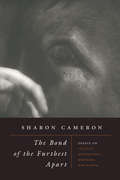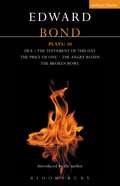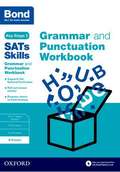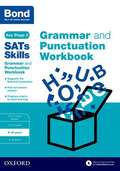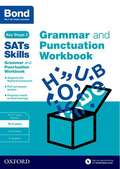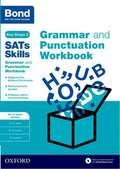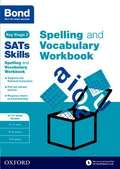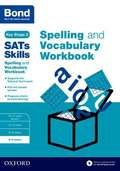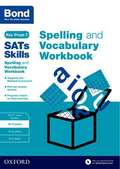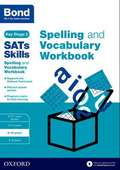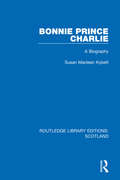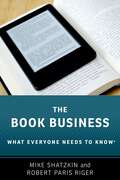- Table View
- List View
The Bond of the Furthest Apart: Essays on Tolstoy, Dostoevsky, Bresson, and Kafka
by Sharon CameronIn the French filmmaker Robert Bresson’s cinematography, the linkage of fragmented, dissimilar images challenges our assumption that we know either what things are in themselves or the infinite ways in which they are entangled. The “bond” of Sharon Cameron’s title refers to the astonishing connections found both within Bresson’s films and across literary works by Tolstoy, Dostoevsky, and Kafka, whose visionary rethinkings of experience are akin to Bresson’s in their resistance to all forms of abstraction and classification that segregate aspects of reality. Whether exploring Bresson’s efforts to reassess the limits of human reason and will, Dostoevsky’s subversions of Christian conventions, Tolstoy’s incompatible beliefs about death, or Kafka’s focus on creatures neither human nor animal, Cameron illuminates how the repeated juxtaposition of disparate, even antithetical, phenomena carves out new approaches to defining the essence of being, one where the very nature of fixed categories is brought into question. An innovative look at a classic French auteur and three giants of European literature, The Bond of the Furthest Apart will interest scholars of literature, film, ethics, aesthetics, and anyone drawn to an experimental venture in critical thought.
The Bond of the Furthest Apart: Essays on Tolstoy, Dostoevsky, Bresson, and Kafka
by Sharon CameronIn the French filmmaker Robert Bresson’s cinematography, the linkage of fragmented, dissimilar images challenges our assumption that we know either what things are in themselves or the infinite ways in which they are entangled. The “bond” of Sharon Cameron’s title refers to the astonishing connections found both within Bresson’s films and across literary works by Tolstoy, Dostoevsky, and Kafka, whose visionary rethinkings of experience are akin to Bresson’s in their resistance to all forms of abstraction and classification that segregate aspects of reality. Whether exploring Bresson’s efforts to reassess the limits of human reason and will, Dostoevsky’s subversions of Christian conventions, Tolstoy’s incompatible beliefs about death, or Kafka’s focus on creatures neither human nor animal, Cameron illuminates how the repeated juxtaposition of disparate, even antithetical, phenomena carves out new approaches to defining the essence of being, one where the very nature of fixed categories is brought into question. An innovative look at a classic French auteur and three giants of European literature, The Bond of the Furthest Apart will interest scholars of literature, film, ethics, aesthetics, and anyone drawn to an experimental venture in critical thought.
The Bond of the Furthest Apart: Essays on Tolstoy, Dostoevsky, Bresson, and Kafka
by Sharon CameronIn the French filmmaker Robert Bresson’s cinematography, the linkage of fragmented, dissimilar images challenges our assumption that we know either what things are in themselves or the infinite ways in which they are entangled. The “bond” of Sharon Cameron’s title refers to the astonishing connections found both within Bresson’s films and across literary works by Tolstoy, Dostoevsky, and Kafka, whose visionary rethinkings of experience are akin to Bresson’s in their resistance to all forms of abstraction and classification that segregate aspects of reality. Whether exploring Bresson’s efforts to reassess the limits of human reason and will, Dostoevsky’s subversions of Christian conventions, Tolstoy’s incompatible beliefs about death, or Kafka’s focus on creatures neither human nor animal, Cameron illuminates how the repeated juxtaposition of disparate, even antithetical, phenomena carves out new approaches to defining the essence of being, one where the very nature of fixed categories is brought into question. An innovative look at a classic French auteur and three giants of European literature, The Bond of the Furthest Apart will interest scholars of literature, film, ethics, aesthetics, and anyone drawn to an experimental venture in critical thought.
The Bond of the Furthest Apart: Essays on Tolstoy, Dostoevsky, Bresson, and Kafka
by Sharon CameronIn the French filmmaker Robert Bresson’s cinematography, the linkage of fragmented, dissimilar images challenges our assumption that we know either what things are in themselves or the infinite ways in which they are entangled. The “bond” of Sharon Cameron’s title refers to the astonishing connections found both within Bresson’s films and across literary works by Tolstoy, Dostoevsky, and Kafka, whose visionary rethinkings of experience are akin to Bresson’s in their resistance to all forms of abstraction and classification that segregate aspects of reality. Whether exploring Bresson’s efforts to reassess the limits of human reason and will, Dostoevsky’s subversions of Christian conventions, Tolstoy’s incompatible beliefs about death, or Kafka’s focus on creatures neither human nor animal, Cameron illuminates how the repeated juxtaposition of disparate, even antithetical, phenomena carves out new approaches to defining the essence of being, one where the very nature of fixed categories is brought into question. An innovative look at a classic French auteur and three giants of European literature, The Bond of the Furthest Apart will interest scholars of literature, film, ethics, aesthetics, and anyone drawn to an experimental venture in critical thought.
The Bond of the Furthest Apart: Essays on Tolstoy, Dostoevsky, Bresson, and Kafka
by Sharon CameronIn the French filmmaker Robert Bresson’s cinematography, the linkage of fragmented, dissimilar images challenges our assumption that we know either what things are in themselves or the infinite ways in which they are entangled. The “bond” of Sharon Cameron’s title refers to the astonishing connections found both within Bresson’s films and across literary works by Tolstoy, Dostoevsky, and Kafka, whose visionary rethinkings of experience are akin to Bresson’s in their resistance to all forms of abstraction and classification that segregate aspects of reality. Whether exploring Bresson’s efforts to reassess the limits of human reason and will, Dostoevsky’s subversions of Christian conventions, Tolstoy’s incompatible beliefs about death, or Kafka’s focus on creatures neither human nor animal, Cameron illuminates how the repeated juxtaposition of disparate, even antithetical, phenomena carves out new approaches to defining the essence of being, one where the very nature of fixed categories is brought into question. An innovative look at a classic French auteur and three giants of European literature, The Bond of the Furthest Apart will interest scholars of literature, film, ethics, aesthetics, and anyone drawn to an experimental venture in critical thought.
The Bond of the Furthest Apart: Essays on Tolstoy, Dostoevsky, Bresson, and Kafka
by Sharon CameronIn the French filmmaker Robert Bresson’s cinematography, the linkage of fragmented, dissimilar images challenges our assumption that we know either what things are in themselves or the infinite ways in which they are entangled. The “bond” of Sharon Cameron’s title refers to the astonishing connections found both within Bresson’s films and across literary works by Tolstoy, Dostoevsky, and Kafka, whose visionary rethinkings of experience are akin to Bresson’s in their resistance to all forms of abstraction and classification that segregate aspects of reality. Whether exploring Bresson’s efforts to reassess the limits of human reason and will, Dostoevsky’s subversions of Christian conventions, Tolstoy’s incompatible beliefs about death, or Kafka’s focus on creatures neither human nor animal, Cameron illuminates how the repeated juxtaposition of disparate, even antithetical, phenomena carves out new approaches to defining the essence of being, one where the very nature of fixed categories is brought into question. An innovative look at a classic French auteur and three giants of European literature, The Bond of the Furthest Apart will interest scholars of literature, film, ethics, aesthetics, and anyone drawn to an experimental venture in critical thought.
Bond Plays: Dea; The Testament of this Day; The Price of One; The Angry Roads; The Hungry Bowl (Contemporary Dramatists)
by Edward BondBond Plays: 10 brings together recent work by the writer of the classic stage plays Saved, Lear, The Pope's Wedding and Early Morning. The volume comprises four previously unpublished plays, one previously published play and a comprehensive introduction by the author.Dea, a heroine, has committed a terrible act and has been exiled. When she meets someone from her past, she is forcefully confronted by the broken society that drove her to commit her crimes. In this play, Edward Bond takes from the Greek and Jacobean drama the fundamental classical problems of the family and war to vividly picture our collapsing society. Dea received its premiere at Sutton Theatre in 2016.The Testament of this Day is Edward Bond's third original radio drama. A young man embarks on two journeys, though he is in control of only one. He soon discovers there is no going back, from either. The play is an arresting drama about the world today and was first produced by BBC Radio 4 in 2016.The Price of One is set in among city ruins in a war zone. An occupying soldier carries a baby he has rescued from the rubble and dust. He meets a woman carrying a baby of her own. What ensues is a struggle between two enemies demanding justice in the midst of war. A modern tragedy, this play is an exploration of eternity and madness and the supermarket culture. It received its premiere in 2016.The Angry Roads considers how young people today grow up in a world that their parents never knew. In a flat a teenage boy is sorting through play things from his childhood; he is sorting through his past in search of the truth about an accident that destroyed his family. The Angry Roads was commissioned by Big Brum Theatre Company and premiered in 2015.The Hungry Bowl is a portrait of a a ghost town. Outside a harsh wind rattles the windows. Inside, people go hungry and start boarding up their homes. When a young girl insists on feeding her imaginary friend, a bitter struggle for a future ensues for the power of the imagination to transform lives. The play is a moving and audacious modern fable that explores the impact of hard times on family life, commissioned by Big Brum and premiered in 2012.The volume features an introduction by the author that looks at theatre and culture in a post-Brexit referendum, post-truth and post-Trump era.
Bond Plays: Dea; The Testament of this Day; The Price of One; The Angry Roads; The Hungry Bowl (Contemporary Dramatists)
by Edward BondBond Plays: 10 brings together recent work by the writer of the classic stage plays Saved, Lear, The Pope's Wedding and Early Morning. The volume comprises four previously unpublished plays, one previously published play and a comprehensive introduction by the author.Dea, a heroine, has committed a terrible act and has been exiled. When she meets someone from her past, she is forcefully confronted by the broken society that drove her to commit her crimes. In this play, Edward Bond takes from the Greek and Jacobean drama the fundamental classical problems of the family and war to vividly picture our collapsing society. Dea received its premiere at Sutton Theatre in 2016.The Testament of this Day is Edward Bond's third original radio drama. A young man embarks on two journeys, though he is in control of only one. He soon discovers there is no going back, from either. The play is an arresting drama about the world today and was first produced by BBC Radio 4 in 2016.The Price of One is set in among city ruins in a war zone. An occupying soldier carries a baby he has rescued from the rubble and dust. He meets a woman carrying a baby of her own. What ensues is a struggle between two enemies demanding justice in the midst of war. A modern tragedy, this play is an exploration of eternity and madness and the supermarket culture. It received its premiere in 2016.The Angry Roads considers how young people today grow up in a world that their parents never knew. In a flat a teenage boy is sorting through play things from his childhood; he is sorting through his past in search of the truth about an accident that destroyed his family. The Angry Roads was commissioned by Big Brum Theatre Company and premiered in 2015.The Hungry Bowl is a portrait of a a ghost town. Outside a harsh wind rattles the windows. Inside, people go hungry and start boarding up their homes. When a young girl insists on feeding her imaginary friend, a bitter struggle for a future ensues for the power of the imagination to transform lives. The play is a moving and audacious modern fable that explores the impact of hard times on family life, commissioned by Big Brum and premiered in 2012.The volume features an introduction by the author that looks at theatre and culture in a post-Brexit referendum, post-truth and post-Trump era.
Bond SATs Skills: 8-9 years
by Michellejoy Hughes Bond SATs SkillsBond Skills Grammar and Punctuation for age 8-9 has been developed by Bond, to begin building core English language skills. With renewed focus on grammar and punctuation throughout the National Curriculum and in academic testing, this book will help children to build the core skills and knowledge expected in key assessments.
Bond SATs Skills: 9-10 years
by Michellejoy Hughes Bond SATs SkillsBond Skills Grammar and Punctuation for age 9-10 has been developed by Bond, to build on core English language skills. With renewed focus on grammar and punctuation throughout the National Curriculum and in academic testing, this book will help children to establish the core skills and knowledge expected in key assessments.
Bond SATs Skills: 10-11 years
by Michellejoy Hughes Bond SATs SkillsBond Skills Grammar and Punctuation for age 10-11 has been developed by Bond to develop the grammar and punctuation knowledge sought in the Grammar, Punctuation and Spelling Test, SATs and through selective school exams. Following on from titles for 8-9 years and 9-10 years, this book focuses on the higher level language skills needed for success.
Bond SATs Skills: 10-11+ years Stretch
by Michellejoy Hughes Bond SATs SkillsBond Skills Grammar and Punctuation for age 10-11 Stretch has been developed by Bond as a step on from the Bond Skills Grammar and Punctuation for age 10-11, to enhance ability in English language skills to levels expected for higher performance in Grammar, Punctuation and Spelling Test, SATs and through selective school exams.
Bond SATs Skills Spelling and Vocabulary Stretch Workbook: 10-11+ years
by Michellejoy Hughes Bond SATs SkillsBond SATs Skills Spelling and Vocabulary Stretch for age 10-11 has been developed by Bond with Oxford Dictionaries to enhance ability in English language skills. Both spelling and vocabulary are now keenly examined throughout the National Curriculum and academic testing; this range of titles focuses on the words expected in key assessments.
Bond SATs Skills Spelling and Vocabulary Workbook: 8-9 years
by Michellejoy Hughes Bond SATs SkillsBond SATs Skills Spelling and Vocabulary for age 8-9 has been developed with Oxford Dictionaries to begin building core English language skills. With renewed focus on spelling and vocabulary throughout the National Curriculum and in academic testing, this book will help children to build core knowledge of the words expected in key assessments.
Bond SATs Skills Spelling and Vocabulary Workbook: 10-11 years
by Michellejoy Hughes Bond SATs SkillsBond SATs Skills Spelling and Vocabulary 10-11 years has been developed with Oxford Dictionaries to build spelling and vocabulary knowledge sought in the Grammar, Punctuation and Spelling Test, SATs and selective school exams. Following on from 8-9 years and 9-10 years, this book focuses on the higher level language skills needed for success.
Bond SATs Skills Spelling and Vocabulary Workbook: 9-10 years
by Michellejoy Hughes Bond SATs SkillsBond SATs Skills Spelling and Vocabulary for age 9-10 has been developed with Oxford Dictionaries to build core English language skills. With renewed focus on spelling and vocabulary throughout the National Curriculum and in academic testing, this book will help children to establish the core knowledge of the words expected in key assessments.
Bone Black: Memories of Girlhood
by bell hooksOne of bell hooks' foundational works introduced to the UK for the first time.'With the emotion of poetry, the narrative of a novel, and the truth of experience, bell hooks weaves a girlhood memoir you won't be able to put down―or forget. Bone Black takes us into the cave of self-creation' Gloria SteinemStitching together the threads of her girlhood memories, bell hooks shows us one strong-spirited child's journey toward becoming the pioneering writer we know. Along the way, hooks sheds light on the vulnerability of children, the special unfurling of female creativity and the imbalance of a society that confers marriage's joys upon men and its silences on women.In a world where daughters and fathers are strangers under the same roof, and crying children are often given something to cry about, hooks uncovers the solace to be found in solitude, the comfort to be had in the good company of books.Bone Black allows us to bear witness to the awakening of a legendary author's awareness that writing is her most vital breath.
Bones (Plays for Young People)
by Tanika GuptaIn 2014 local historian Catherine Corless made a discovery of baby bones and skeletons in the grounds of a mother and baby home in Tuam, County Galway, Ireland. Built on the grounds of an old workhouse that operated between 1921 and 1961 the discovery threw up questions about the goings-on across this and similar institutions across Ireland. Tanika Gupta's powerful drama is loosely based on these recent and historical events, drawing inspiration from Corless' discovery.Told through the eyes of Grace and her grandchildren, Bones is a play about loss, punishment of unmarried mothers and the legacy of the demonisation of women by Church and State, where the human and reproductive rights of women are undermined.Bones premiered at the Royal Central School of Speech and Drama in 2019.Bones is published in Methuen Drama's Plays For Young People Age 16+ series which offers suitable plays for young performers at schools, youth groups and youth theatres that have each had premiere productions by young performers in the UK.
Bones (Plays for Young People)
by Tanika GuptaIn 2014 local historian Catherine Corless made a discovery of baby bones and skeletons in the grounds of a mother and baby home in Tuam, County Galway, Ireland. Built on the grounds of an old workhouse that operated between 1921 and 1961 the discovery threw up questions about the goings-on across this and similar institutions across Ireland. Tanika Gupta's powerful drama is loosely based on these recent and historical events, drawing inspiration from Corless' discovery.Told through the eyes of Grace and her grandchildren, Bones is a play about loss, punishment of unmarried mothers and the legacy of the demonisation of women by Church and State, where the human and reproductive rights of women are undermined.Bones premiered at the Royal Central School of Speech and Drama in 2019.Bones is published in Methuen Drama's Plays For Young People Age 16+ series which offers suitable plays for young performers at schools, youth groups and youth theatres that have each had premiere productions by young performers in the UK.
Bonnie Prince Charlie: A Biography (Routledge Library Editions: Scotland #14)
by Susan Maclean KybettOriginally published in 1988, this biography was the result of 15 years research, including unearthing 70,000 letters and documents among the Stuart Papers which had hitherto lain largely untapped. Written in many different languages, some were damaged, written in code, or unsigned and undated. Deciphering them therefore made it possible to gain a new level of insight into Bonnie Prince Charlie as a man, his relationship with his exiled father, the role played by France and the true nature of the events leading up to the bloody campaign of 1745 in which he attempted to win back the throne of his ancestors.
Bonnie Prince Charlie: A Biography (Routledge Library Editions: Scotland #14)
by Susan Maclean KybettOriginally published in 1988, this biography was the result of 15 years research, including unearthing 70,000 letters and documents among the Stuart Papers which had hitherto lain largely untapped. Written in many different languages, some were damaged, written in code, or unsigned and undated. Deciphering them therefore made it possible to gain a new level of insight into Bonnie Prince Charlie as a man, his relationship with his exiled father, the role played by France and the true nature of the events leading up to the bloody campaign of 1745 in which he attempted to win back the throne of his ancestors.
Book and Text in France, 1400–1600: Poetry on the Page
by Malcolm QuaintonIn recent years, literary scholars have come increasingly to acknowledge that an adequate understanding of texts requires the study of books, the material objects through which the meanings of texts are constructed. Focusing on French poetry in the period 1400-1600, contributors to this volume analyze layout, illustration, graphology, paratext, typography, anthologization, and other such elements in works by a variety of writers, among them Charles d'Orléans, Jean Bouchet, Pierre de Ronsard and Louise Labé. They demonstrate how those elements play a crucial role in shaping the relationships between authors, texts, contexts, and readers, and how these relationships change as the nature of the book evolves. An introduction to the volume outlines the methodological implications of studying the materiality of literature in this period; situates the various papers in relation to each other and to the field as a whole; and indicates possible future directions of research in the field. By engaging with issues of major current methodological concern, this volume appeals to all scholars interested in the materiality of the literary text, including the burgeoning field of text-image studies, not only in French but also in other national literatures. In addition, it enables fruitful connections to be made between late-medieval and Renaissance literature, areas still often studied in isolation from each other.
Book and Text in France, 1400–1600: Poetry on the Page
by Malcolm QuaintonIn recent years, literary scholars have come increasingly to acknowledge that an adequate understanding of texts requires the study of books, the material objects through which the meanings of texts are constructed. Focusing on French poetry in the period 1400-1600, contributors to this volume analyze layout, illustration, graphology, paratext, typography, anthologization, and other such elements in works by a variety of writers, among them Charles d'Orléans, Jean Bouchet, Pierre de Ronsard and Louise Labé. They demonstrate how those elements play a crucial role in shaping the relationships between authors, texts, contexts, and readers, and how these relationships change as the nature of the book evolves. An introduction to the volume outlines the methodological implications of studying the materiality of literature in this period; situates the various papers in relation to each other and to the field as a whole; and indicates possible future directions of research in the field. By engaging with issues of major current methodological concern, this volume appeals to all scholars interested in the materiality of the literary text, including the burgeoning field of text-image studies, not only in French but also in other national literatures. In addition, it enables fruitful connections to be made between late-medieval and Renaissance literature, areas still often studied in isolation from each other.
The Book Beautiful: Walter Pater and the House of Macmillan (Bloomsbury Academic Collections: English Literary Criticism)
by Robert M. SeilerThe letters collected here comprise an important chapter in the life of Walter Pater's literary career. They record in great detail the relations between this Victorian man of letters and his publisher, Macmillan and Co. Specifically they illustrate how such discussions affected the form as well as the content of his books. The book provides a very full illustration and analysis of the crucial influence of the author-publisher relationship to literature.
The Book Business: What Everyone Needs to Know® (What Everyone Needs To Know®)
by Mike Shatzkin Robert Paris RigerMany of us read books every day, either electronically or in print. We remember the books that shaped our ideas about the world as children, go back to favorite books year after year, give or lend books to loved ones and friends to share the stories we've loved especially, and discuss important books with fellow readers in book clubs and online communities. But for all the ways books influence us, teach us, challenge us, and connect us, many of us remain in the dark as to where they come from and how the mysterious world of publishing truly works. How are books created and how do they get to readers? The Book Business: What Everyone Needs to Know® introduces those outside the industry to the world of book publishing. Covering everything from the beginnings of modern book publishing early in the 20th century to the current concerns over the alleged death of print, digital reading, and the rise of Amazon, Mike Shatzkin and Robert Paris Riger provide a succinct and insightful survey of the industry in an easy-to-read question-and-answer format. The authors, veterans of "trade publishing," or the branch of the business that puts books in our hands through libraries or bookstores, answer questions from the basic to the cutting-edge, providing a guide for curious beginners and outsiders. How does book publishing actually work? What challenges is it facing today? How have social media changed the game of book marketing? What does the life cycle of a book look like in 2019? They focus on how practices are changing at a time of great flux in the industry, as digital creation and delivery are altering the commercial realities of the book business. This book will interest not only those with no experience in publishing looking to gain a foothold on the business, but also those working on the inside who crave a bird's eye view of publishing's evolving landscape. This is a moment of dizzyingly rapid change wrought by the emergence of digital publishing, data collection, e-books, audio books, and the rise of self-publishing; these forces make the inherently interesting business of publishing books all the more fascinating.
